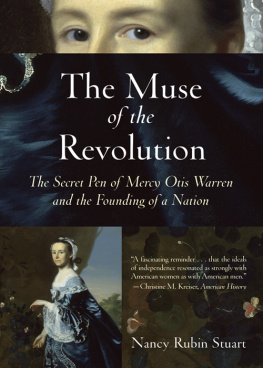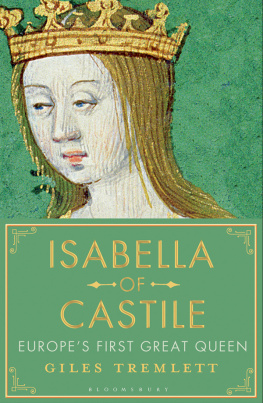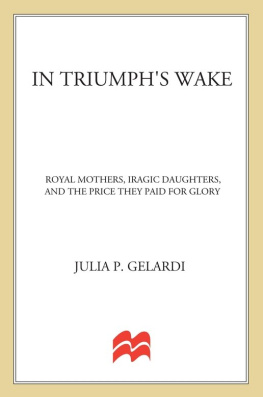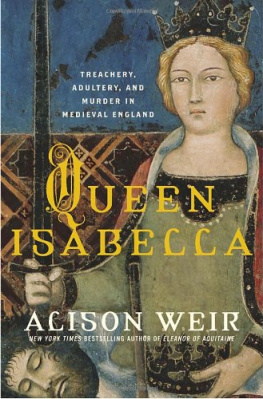Nancy Rubin - Isabella of Castile: The First Renaissance Queen
Here you can read online Nancy Rubin - Isabella of Castile: The First Renaissance Queen full text of the book (entire story) in english for free. Download pdf and epub, get meaning, cover and reviews about this ebook. year: 1991, publisher: St Martins Pr, genre: Non-fiction. Description of the work, (preface) as well as reviews are available. Best literature library LitArk.com created for fans of good reading and offers a wide selection of genres:
Romance novel
Science fiction
Adventure
Detective
Science
History
Home and family
Prose
Art
Politics
Computer
Non-fiction
Religion
Business
Children
Humor
Choose a favorite category and find really read worthwhile books. Enjoy immersion in the world of imagination, feel the emotions of the characters or learn something new for yourself, make an fascinating discovery.
- Book:Isabella of Castile: The First Renaissance Queen
- Author:
- Publisher:St Martins Pr
- Genre:
- Year:1991
- Rating:5 / 5
- Favourites:Add to favourites
- Your mark:
- 100
- 1
- 2
- 3
- 4
- 5
Isabella of Castile: The First Renaissance Queen: summary, description and annotation
We offer to read an annotation, description, summary or preface (depends on what the author of the book "Isabella of Castile: The First Renaissance Queen" wrote himself). If you haven't found the necessary information about the book — write in the comments, we will try to find it.
Nancy Rubin: author's other books
Who wrote Isabella of Castile: The First Renaissance Queen? Find out the surname, the name of the author of the book and a list of all author's works by series.
Isabella of Castile: The First Renaissance Queen — read online for free the complete book (whole text) full work
Below is the text of the book, divided by pages. System saving the place of the last page read, allows you to conveniently read the book "Isabella of Castile: The First Renaissance Queen" online for free, without having to search again every time where you left off. Put a bookmark, and you can go to the page where you finished reading at any time.
Font size:
Interval:
Bookmark:
Table of Contents
ISABELLA OF CASTILE
A WORD ABOUT MONEY
It is very difficult to compare the value of coins of the late fifteenth century with modern ones. Not only did their monetary value fluctuate during Isabella and Ferdinand's era, but the buying power of money was considerably different than it is today. During Isabella's era, the maravedi was the standard unit of account. By 1480, the dobla, a 19-carat gold coin, was worth 445 maravedis and the Aragonese florin 265 maravedis.
In 1497 the Castilian monarchs introduced and standardized other currencies. Foremost among these was the gold excelente which was roughly equivalent to the Florentine florin and the Venetian ducat. In Castile, the excelente was equivalent to 375 maravedis, the silver real worth 34 maravedis, and the copper blanca, whose value was 1/2 a maravedi. How much would a maravedi buy? In the late fifteenth century, a common laborer would earn 15 to 20 maravedis a day, a carpenter or mason about 40 maravedis for the same day's work.
PART ONE: An Embattled Princess 1451-1468
CHAPTER ONE
Dona Isabel, Queen Proprietress of Castile
On Tuesday afternoon, December 13, 1474, thirty nobles assembled outside the turreted castle of Segovia to await Princess Isabella of Castile. The finely spun gold threads of their jerkins glittered in the winter light, and high fur collars and black broad-brimmed hats protected their clean-shaven faces from the cold. A few hundred feet away Segovian artisans, merchants, and peasants began to gather in small groups. They too waited patiently, for rumors had swirled through the bustling wool-trade town for two days since King Enrique IV 's deathrumors made all the more credible by the constant clatter of horses pounding over the castle's wooden drawbridgethat Isabella, Princess of As-turias, was about to be crowned the new Queen of Castile.
Above the human panorama loomed the eleventh-century alcazarcastle with its azure turrets and massive ocher keep, poised 328 feet above the confluence of the Eresma and Clamores rivers. For nearly three centuries since feudal warriors wrested Segovia from Moorish rule and reconquered Castile for Christianity, guards sat in its watchtowers to scan the surrounding plains and wheat fields beneath its rocky edge. From the highest tower one guard could see that nearly the entire Segovian population had emptied onto the streets in anticipation of Isabella's appearance. Grimy-faced blacksmiths, aproned tanners, brightly dressed bawds, cripples, tonsured monks, young matrons and their children, Jewish merchants, even millers and shepherds from far ends of the city had ceased their work and now choked the city's streets. In their haste they had scattered the chickens, pigs, and goats that wandered the maze of hilly roads and muddy ditches just beyond the alcazar.
In contrast to the buzzing crowds of commoners, the nobles clustered silently around the castle entrance like a shield, their solemn dignity as remarkable as their splendid clothes. These grandees, or ricos hombres, as Spain's most ancient aristocrats were called, welcomed the russet-haired, twenty-three-year-old princess who was now within the alcazar making final preparations for the coronation. With her crowning, years of intrigue, civil strife, and bloodshed were about to be resolved.
At the appointed hour, Isabella appeared at the castle entrance in a rich brial, an elegant gown shimmering with jewels that swept to her ankles. Around her neck was a gold necklace set with gems and pearls. A large dark ruby glittered in its center. Isabella moved gracefully toward a richly harnessed horse, her steady and dignified gait revealing little of the tumultuous emotions that had gripped her in the thirty-six hours since her half brother, King Enrique IV of Castile, had died.
Foreign ambassadors and court observers of the day considered Isabella a beautiful woman. Like her Visigoth ancestors who had invaded Spain from the northern German territories a thousand years earlier, Isabella was a strawberry blondecoloring especially admired in Castile because of its relative rarity.
Isabella's finely chiseled face and lively expression gave her a "comely aspect" that was not soon forgotten.1 One courtier even remarked that she was "the handsomest lady I ever beheld."2 According to her court secretary and historian of her reign, Fernando del Pulgar, Isabella was of medium height, "well formed in her person and the proportion of her limbs... very fair and blond: her eyes between green and blue, her look gracious and honest... her well-shaped face... beautiful and happy."3
While such accolades sound like court flattery, all commentators agree that Isabella was "the most gracious in her manners."4 Whether beautiful or not, Isabella's youthful vitality, gentleness, and personal charisma made her extremely attractive to all who beheld her.
A day and a half earlieron December 11King Enrique, Isabella's fifty-yearold half brother, had died suddenly a few minutes before midnight. Two days before, with stubborn disregard for his doctors' orders, the ailing king had gone hunting in his private woods near Madrid. After his collapse he was rushed back to the Madrid palace. Although Enrique had suffered a stomach illness for months, his death came as a cruel shock to the Castilians because he had failed to name an heir to the throne. His ministers had begged the dying king to name either his twelve-year-old daughter, Juana, or his half sister, Isabella, as his successor. Later, there were rumors that Enrique told his secretary, Juan Gonzalez, that Princess Juana should be his heir and left a will to that effect. But Gonzalez's claim was mistrusted and the will never found. Such indecision was typical of Enrique. The King had hedged his bets for the last five years of his life, partly out of ambivalence, partly out of genuine fear, hoping to quell the seething aristocratic factions that threatened to tear Castile apart.
Perhaps Enrique did not believe he would die and planned to settle the question of the succession later. Or perhaps, sickened as much by the harrowing events of his reign as from the pains that tore at his belly, he now avenged himself upon Castile by dying silent. In either case Enrique's death left Castile shaken, its political integrity threatened, and its citizens unnerved by roaming packs of bandits, inflated bread and wine prices, and the likelihood of a new civil war. Castile was ripe for a political change, be it for better or for worse.
Isabella's allies lost no time in seizing the initiative. For nearly a year the princess had been living in Segovia with her childhood friend, Beatriz de Bobadilla, whose capable husband Andres de Cabrera was governor of Segovia's alcazar. Respected by Enrique and sympathetic to Isabella's cause, Cabrera was entrusted with the Castilian treasury, which was housed within the formidable Segovian fortress.
Clearly, Isabella's location at the time of Enrique's death and Cabrera's friendship were indisputable advantages to her ascension. And so was Isabella's popularity with many of Castile's most powerful grandees and its common citizens. When Enrique's death was announced, Isabella's supporters urged her to assume the throne immediately. A hasty coronation was essential, they insisted.
Politically, the advice of Isabella's counselors made sense. If she could be enthroned quickly, horseback couriers would immediately ride to Castile's major cities and towns announcing her ascension as the new Queen of Castile and Leon. It was anticipated that the towns would express their approval by return courier. Later, when the Cortes, or parliament of Castile's cities, convened, Isabella would be formally recognized as queen. By the time Princess Juana's allies rallied and attempted to raise her to the throne, Isabella's coronation would have been long accepted by Castile's aristocrats, clergy, and commoners.
Next pageFont size:
Interval:
Bookmark:
Similar books «Isabella of Castile: The First Renaissance Queen»
Look at similar books to Isabella of Castile: The First Renaissance Queen. We have selected literature similar in name and meaning in the hope of providing readers with more options to find new, interesting, not yet read works.
Discussion, reviews of the book Isabella of Castile: The First Renaissance Queen and just readers' own opinions. Leave your comments, write what you think about the work, its meaning or the main characters. Specify what exactly you liked and what you didn't like, and why you think so.








